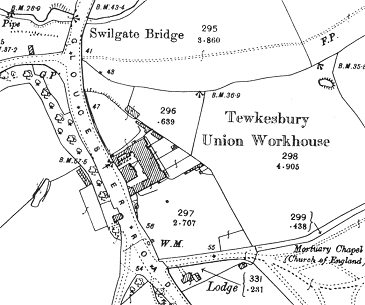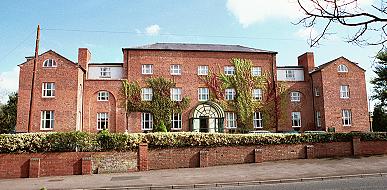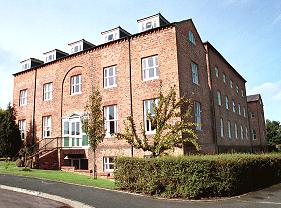Tewkesbury, Gloucestershire
Up to 1834
A Parliamentary report of 1776 recorded parish workhouses in operation in Tewkesbury with accommodation for up to 36 inmates, and at Overbury for up to 11 inmates. Following a local Act of 1792, a House of Industry was erected in the town in 1792-6 at a site to the south of the town on the Gloucester Road. The designer may have been George Byfield, a designer of gaols.
After 1834
Tewkesbury Poor Law Union was formed on 16th November 1835. Its operation was overseen by an elected Board of Guardians, 30 in number, representing its 23 constituent parishes as listed below (figures in brackets indicate numbers of Guardians if more than one):
County of Gloucester:
Ashchurch, Beddington, Deerhurst (2), Elmstone Hardwicke, Forthampton, Hasfield, Kemerton, Leigh, Oxenton, Stoke Orchard, Tewkesbury (5), Tirley, Twyning (2), Walton Cardiff, Woolstone.
County of Worcester:
Bredon (2), Norton-by-Bredon, Chaceley, Conderton, Overbury, Pendock, Teddington.
The population falling within the Union at the 1831 census had been 14,193 with parishes ranging in size from Walton Cardiff (population 57) to Tewkesbury itself (5,780). The average annual poor-rate expenditure for the period 1833-5 had been £7,710 or 10s.10d. per head.
In 1838, the existing House of Industry was formally taken over by the new Tewkesbury Union for which the Poor Law Commissioners authorised the expenditure of £4,600.
The workhouse location and layout are shown on the 1901 map below.

Tewkesbury workhouse site, 1901.
The building comprised a main block of three storeys, increasing to four at the rear where the ground slopes away. There were originally wings at each side, probably single storey out-buildings, and small separate block at the roadside to the west.

Tewkesbury from the west, 2000.
© Peter Higginbotham.

Tewkesbury from the south-east, 2000.
© Peter Higginbotham.
In 1930, the site was taken over by Gloucestershire Council and became Holmwood House Public Assistance Institution. In 1948, it joined the National Health Service as Holm Hospital, providing geriatric care until its closure in 1969. After a period of dereliction, the building was renovated in the early 1990s to become the Shepherd Mead retirement homes.
Some modern residents of the building claim that a ghost inhabits its walls. In the adjacent retirement bungalows, which were built on the site of the former workhouse graveyard, the sounds of crying children have also been reported.
Staff
Inmates
Records
Note: many repositories impose a closure period of up to 100 years for records identifying individuals. Before travelling a long distance, always check that the records you want to consult will be available.
- Gloucestershire Archives, Clarence Row, Alvin Street, Gloucester GL1 3DW. Holdings include: Guardians' minute books (1835-1930); Admissions and discharges (1916-48); Register of inmates (1911-53); etc.
Bibliography
- Higginbotham, Peter The Workhouse Encyclopedia (2014, The History Press)
Links
- None.
Unless otherwise indicated, this page () is copyright Peter Higginbotham. Contents may not be reproduced without permission.


